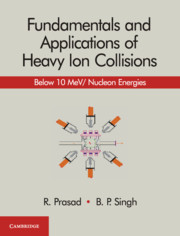2 - Theoretical Tools, Reaction Mechanism and Computer Codes
Published online by Cambridge University Press: 20 October 2018
Summary
Complete Fusion of Heavy Ions
Complete fusion of heavy ions is theoretically treated in the framework of a statistical compound reaction mechanism. In heavy ion collisions, a large number of resonances is excited in the compound system, involving many degrees of freedom. A complete description of such a complex collision process is almost impossible to obtain. However, the mean value of crosssection averaged over several resonances is generally of interest, and can be estimated using the statistical approach. The statistical compound reaction model is founded on the works of Bohr, Bethe, and Weisskopf. Wolfenstein and Hauser and Feshbach extended the model to include the conservation of total angular momentum. The statistical compound model was further refined by Moldauer and Lane and Lynn.
Nuclear reactions may be classified in terms of different parameters, including the reaction time. Fast reactions involving reaction times of the order of the time taken by a nucleon to pass through the nucleus (≈10–21 s) corresponds to direct reactions. Slower processes of reaction times of the order of 10–16 s or so come in the category of compound and pre-compound (or pre-equilibrium, or multistep compound and multistep direct) reactions. The compound reaction mechanism, being the slowest, assumes that the excited compound nucleus formed by the fusion of the target and the projectile lives long enough, without decay, for thorough mixing of the target and projectile nucleons to take place and a thermodynamic equilibrium be established in the compound system. Sometimes, it is convenient to call the fused system formed by the amalgamation of the projectile with the target, before the establishment of thermal equilibrium, as an excited composite system that becomes the compound nucleus (CN) when thermal equilibrium is established. Pre-compound reactions occur during the time taken by the excited composite system to transit to the compound nucleus. In this section, we consider the pure compound reaction mechanism and assume that the composite system becomes a compound nucleus without losing any nucleons or clusters. Almost all nuclear models that aim to determine reaction cross-sections make use of the optical model which enables the separation of the total cross-section into different components and provides transmission coefficients that are used in the compound nucleus model.
- Type
- Chapter
- Information
- Fundamentals and Applications of Heavy Ion CollisionsBelow 10 MeV/ Nucleon Energies, pp. 36 - 87Publisher: Cambridge University PressPrint publication year: 2018

